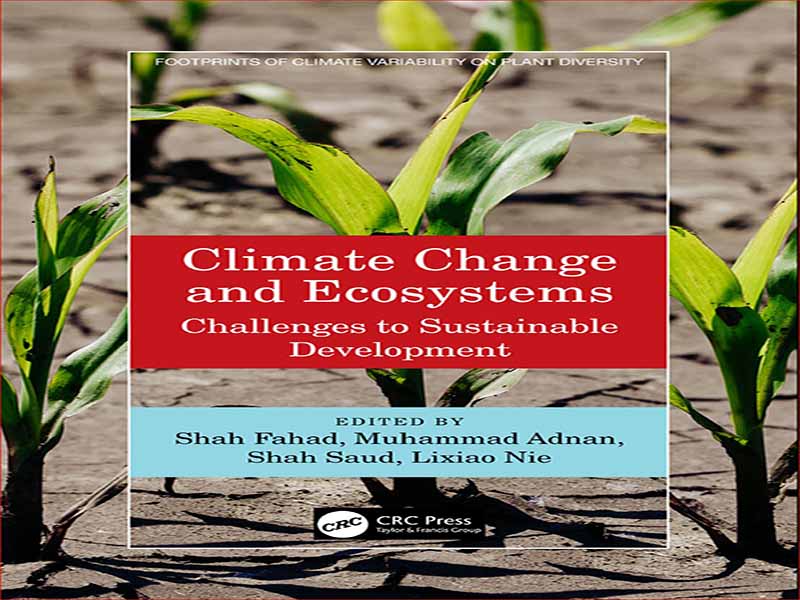- عنوان کتاب: Climate Change and Ecosystems Challenges to Sustainable Development
- نویسنده: Shah-Fahad,-Muhammad-Adnan,-Shah-Saud
- حوزه: تغییرات اقلیم
- سال انتشار: 2022
- تعداد صفحه: 279
- زبان اصلی: انگلیسی
- نوع فایل: pdf
- حجم فایل: 12.5 مگابایت
پیش بینی می شود که جمعیت جهان از 6.7 میلیارد در سال 2008 به 3.3 میلیارد نفر در سال 2008 به 10 میلیارد نفر در سال 2100 افزایش یابد. در نتیجه، تخریب خاک و بیابان زدایی به دلیل افزایش تقاضا برای مواد غذایی، خوراک، فیبر و سوخت در منابع خاکی fnite در حال رشد است. مشکل ناامنی غذایی جهانی ممکن است با تهدید گرمایش جهانی بدتر شود. تغییرات اقلیمی تأثیرات خود را از نظر افزایش دما، بارندگی متغیر و افزایش افراطهای مرتبط با اقلیم مانند غذاها، خشکسالی، طوفان، افزایش سطح دریا، شوری و فرسایش خاک نشان میدهد. بخش کشاورزی حساس ترین بخش به تغییرات آب و هوایی است زیرا آب و هوای یک منطقه/کشور ماهیت و ویژگی های پوشش گیاهی و محصولات را تعیین می کند. افزایش میانگین دمای فصلی و کاهش بارندگی موثر میتواند طول مدت بسیاری از محصولات را کاهش داده و منجر به شیوع آفات و بیماریها و در نتیجه کاهش عملکرد نهایی و در نهایت امنیت غذایی کشور شود. علیرغم تأثیر مثبت لقاح CO2، بهره وری خالص ممکن است به دلیل افزایش نرخ تنفس، تنش خشکی و کمبود مواد مغذی کاهش یابد. به عنوان مثال، به ازای هر 75 پی پی ام افزایش غلظت CO2، عملکرد برنج 0.5 تن در هکتار افزایش می یابد، اما بازده برنج به ازای هر 1 درجه سانتی گراد افزایش دما، 0.6 تن در هکتار کاهش می یابد. انتظار می رود بهره وری کشاورزی جهانی تا سال 2080 از 3 درصد به 16 درصد کاهش یابد. کاهش تخمین زده شده در بهره وری کشاورزی در کشورهای در حال توسعه بین 10 تا 25 درصد در دهه 2080 است، جایی که میانگین دمای هوا در حال حاضر نزدیک یا بالاتر از سطح تحمل محصول است. این کتاب در نظر گرفته شده است تا به عنوان مجموعه ای محرک عمل کند که به بحث و تأمل در مورد آینده پایدار کشاورزی و تولید مواد غذایی در مواجهه با تغییرات جهانی کمک کند.
The global population is projected to increase by 3.3 billion from 6.7 billion in 2008 to 10 billion in 2100. As a result, soil degradation and desertifcation are growing due to the increasing demand for food, feed, fber, and fuel on fnite soil resources. The problem of global food insecurity may be further worsened by the threat of global warming. Climate change is showing its impacts in terms of increasing temperatures, variable rainfall, and an increase in climate-related extremes such as foods, droughts, cyclones, sea-level rise, salinity, and soil erosion. The agriculture sector is the most sensitive to climate change because the climate of a region/country determines the nature and characteristics of vegetation and crops. Increase in the mean seasonal temperature and decrease in effective precipitation can reduce the duration of many crops, may lead to outbreaks of pests and diseases, and hence reduce fnal yield ultimately affecting the food security of the country. Despite the positive impact of CO2 fertilization, the net productivity may decrease because of an increase in respiration rate, drought stress, and nutrient defciency. For example, for every 75ppm increase in CO2 concentration, rice yields will increase by 0.5 t/ha, but the yield will decrease by 0.6 t/ha for every 1°C increase in temperature. The global agricultural productivity is expected to decrease from 3% to 16% by 2080. The estimated decrease in agricultural productivity in the developing countries is 10%–25% in the 2080s, where average air temperature is already near or above crop tolerance levels. This book is intended to serve as a stimulating collection that will contribute to debate and refection on the sustainable future of agriculture and food production in the face of global change.
این کتاب را میتوانید از لینک زیر بصورت رایگان دانلود کنید:
Download: Climate Change and Ecosystems Challenges to Sustainable Development



































نظرات کاربران